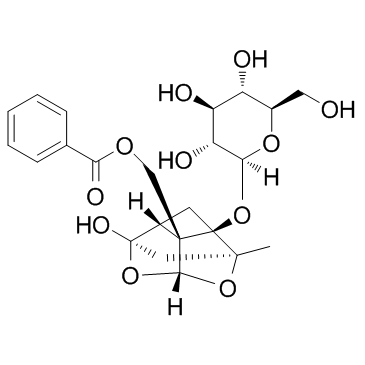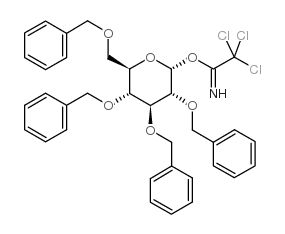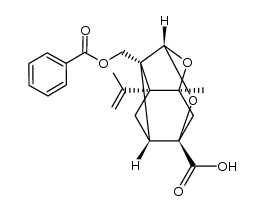23180-57-6
| Name | Paeoniflorin |
|---|---|
| Synonyms |
paeoniflorine
Paeony root Delmacinone Paeonia moutan peoniflorin MFCD00869331 Paeonia lactiflora P,E, Paeoniflorm EINECS 245-476-2 PAEONIFLORIN(P) ,Peoniflorin PACLITAXEL |
| Description | Paeoniflorin is a herbal constituent extracted from the root of Paeonia albiflora Pall.Target: OthersPaeoniflorin (PF) is the principal bioactive component of Radix Paeo- niae alba, which is widely used in Traditional Chinese Medicine for the treatment of neurodegenerative disorders such as Parkinson's disease(PD) [1]. Paeoniflorin, a compound found in white peony that inhibited the production of testosterone and promoted the activity of aromatase, which converts testosterone into estrogen [2]. Treatment of cells with paeoniflorin but not glycyrrhizin resulted in enhanced phosphorylation and acquisition of the deoxyribonucleic acid-binding ability of heat shock transcription factor 1 (HSF1), as well as the formation of characteristic HSF1 granules in the nucleus, suggesting that the induction of HSPs by paeoniflorin is mediated by the activation of HSF1. Also, thermotolerance was induced by treatment with paeoniflorin but not glycyrrhizin. Paeoniflorin had no toxic effect at concentrations as high as 80 microg/ mL (166.4 microM). To our knowledge, this is the first report on the induction of HSPs by herbal medicines [3]. |
|---|---|
| Related Catalog | |
| References |
| Density | 1.6±0.1 g/cm3 |
|---|---|
| Boiling Point | 690.2±55.0 °C at 760 mmHg |
| Molecular Formula | C23H28O11 |
| Molecular Weight | 480.462 |
| Flash Point | 238.4±25.0 °C |
| Exact Mass | 480.163147 |
| PSA | 164.37000 |
| LogP | -0.42 |
| Vapour Pressure | 0.0±2.3 mmHg at 25°C |
| Index of Refraction | 1.683 |
| Storage condition | room temp |
CHEMICAL IDENTIFICATION
HEALTH HAZARD DATAACUTE TOXICITY DATA
|
| Hazard Codes | Xn,N,T,F |
|---|---|
| Risk Phrases | R22:Harmful if swallowed. R50:Very Toxic to aquatic organisms. R39/23/24/25:Toxic: danger of very serious irreversible effects through inhalation, in contact with skin and if swallowed . R23/24/25:Toxic by inhalation, in contact with skin and if swallowed |
| Safety Phrases | S61-S45-S36/37 |
| RIDADR | UN 3077 9/PG 3 |
| WGK Germany | 2 |
| RTECS | XZ3015000 |
| HS Code | 2932999099 |
|
~% 
23180-57-6 |
| Literature: Journal of the American Chemical Society, , vol. 116, # 9 p. 4081 - 4082 |
|
~% 
23180-57-6 |
| Literature: Journal of the American Chemical Society, , vol. 116, # 9 p. 4081 - 4082 |
|
~% 
23180-57-6 |
| Literature: Journal of the American Chemical Society, , vol. 116, # 9 p. 4081 - 4082 |
|
~% 
23180-57-6 |
| Literature: Journal of the American Chemical Society, , vol. 116, # 9 p. 4081 - 4082 |
|
~% 
23180-57-6 |
| Literature: Journal of the American Chemical Society, , vol. 116, # 9 p. 4081 - 4082 |
|
~% 
23180-57-6 |
| Literature: Journal of the American Chemical Society, , vol. 116, # 9 p. 4081 - 4082 |
|
~% 
23180-57-6 |
| Literature: Journal of the American Chemical Society, , vol. 116, # 9 p. 4081 - 4082 |
|
~% 
23180-57-6 |
| Literature: Journal of the American Chemical Society, , vol. 116, # 9 p. 4081 - 4082 |
| Precursor 3 | |
|---|---|
| DownStream 0 | |
| HS Code | 2932999099 |
|---|---|
| Summary | 2932999099. other heterocyclic compounds with oxygen hetero-atom(s) only. VAT:17.0%. Tax rebate rate:13.0%. . MFN tariff:6.5%. General tariff:20.0% |





